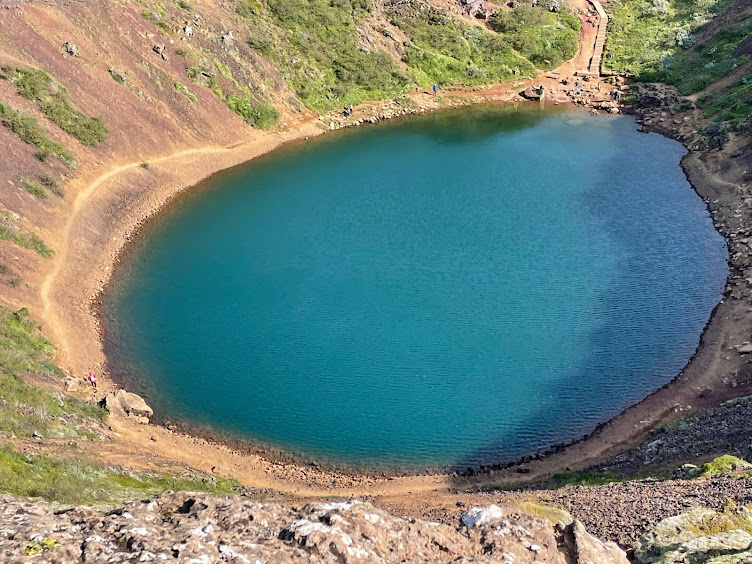During
the period of independence (314-166 BC) the rulers of the Hellenistic states
vied with each other in constructing magnificent buildings on Delos, where all
Greeks could gaze upon and marvel the wealth and power of the cities that had
built them. The kings of Permagum built (mid 3rg cent BC) stoa or portico on
the east side of the Sacred Way that led from the Hellenistic port to the
entrance of the Sanctuary.
Journey by the ship
was about one hour but ship did a stop near a small island so tourists can jump
to the about 30-40 feet deep sea and swim around the ship and swim to the
nearby island. The golden beaches and turquoise waters were breathlessly
beautiful. Then we were taken to the Delos Island.
Immediately
after the Oikos of the Naxians are the three temples of Apollo. The first,
which was also the largest, was dedicated by the Delians and is therefore known
as the Great temple, or Temple of the Delians. Construction, which was funded
by the Treasury of Delian league, began in about 476 BC.
The Delian League was founded in 478, to organize between 150 and 173 Greek city-states into an alliance against the forces of the Persian Empire led by Xerxes I. The League was led by Athens, but held its official meetings in the temple on Delos and based its treasury on the island. The Greek forces had defeated the Persians at the Battle of Plataea the year before, and the Delian League was formed to organize the continuing resistance against this second Persian invasion.
The oldest temple of Apollo, the Poros
Temple of Porinos Oikos was built of Poros stones during either the period of
Athenian tyrant Peisistratus, or that of his sons, in the late 6th century BC.
The famous statue of Apollo created by the Athenian sculptors Tectaeus and
Angelion originally stood in this temple and was later transferred to the Great
Temple.


The Agora of Theophrastos
take its name from the Atenian who was the governor of the island in 126/125 BC
and who had "laid out this agora and backfilled the edge of the port"
as recalled by the dedication of his statue which was established on the square
by "Athenians living in Delos, merchants, shipowners, Romans and other foreigners
staying Delos."
Italians began settling on Delos as early as the 3rd cent. BC, their presence becoming stronger after the mid-2nd cent. BC with Rome's rise to predominance. Most were bankers and merchants from South Italy and Sicily organised in various professional societies, each under the patronage of a god, whether Apollo (Apoloniasts), Poeidoniasts or Hermes (Hermaists). Towards the end of the 2nd cent. BC, they built so-called Agora of the Italians, the meeting place for the members of the Italian community.
The Lions of Naxians are the statues of the lions dedicated by the Naxians to the Sanctuary of Apollo about the 7th cent. BC, within the context of a grandiose building programme which was to demonstrate the supremacy of Naxos of all Hellenic pilgrims. Most pilgrims never seen a lion and I am puzzled by this because there were no lions in these part of the world at that time. (and now)
The establishment of the Poseidoniasts
from Beirut is above. Four columns of the northwest of the Lions mark the building that
house the Poseidoniasts from Berytus (currently Beirut). It was built in
the 2nd cent. BC, as a religious and commercial centre, as well a club house
for merchants, ship owners and warehouse owners from Beirut, the great
commercial city of ancient Syria.
The lake Market was excavated in 2002. The
market was burned down in the 69 BC during the raid of Athenodoros.
The lake house Dillion was constructed in
the last decades of the 2nd cent. BC, it has inhabited by at least 2
generations of the same family, and was burned down in 69 BC. The houses of
Delos, like modern houses, very greatly in their floor plan, which was
determined by the shape and size of the lot, the wishes of the owner, how much
he could afford to spend, and the charges of made by the later generations. A
common feature is that they all look inward: the rooms are built around a
square central court from which they receive light and air, and there are no exteriors
windows on the ground floor.
I think these are for griding millet or
other pulses. We can see similar grinding millets (finger millets) in Sri
Lanka from that era.
These are the theatre quarter and the
remaining temples.
Finally, it was time to go back from this
long but meaningful day. We still missed some parts like going up to the hill.
Well, there will be other chances to come to this magnificent place.












































































